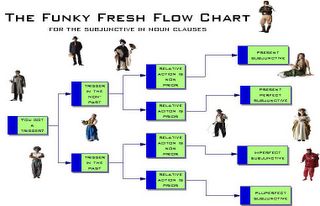
Click the photo for a larger image.
Sentences with a subjunctive in the noun clause almost always follow this pattern:
independent clause (trigger) + relativizer (que) + dependent clause.
Start on the left and decided if your independent clause triggers the subjunctive. If it does, decide if your independent clause is in the past or not. Then look at the action in the dependent clause: prior or not prior to the independent clause?
At that point, just follow the arrow to see what tense your dependent clause will be in.
See? Choosing the correct subjunctive tense is as easy as asking yourself three questions:
- trigger: yes or no?
- independent clause: past or not?
- dependent clause action: prior or not prior to independent clause
I'm glad you're didn't die.
1) trigger? Yes: I'm glad.
2) independent clause: I'm glad (not past)
3) dependent clause action: you didn't die. Prior or not prior to I'm glad? prior!
Did you follow the flowchart? If you did, you will find your finger on present perfect subjunctive.
So let's all say it in Spanish: Me alegro de que tú no hayas muerto.
Piece of cake.






1 comment:
Wow am I glad we're just learning the preterite tense in my Spanish class right now. That looks complicated.
And to think, I used to complain about the stem-changing verbs...(in other words, whenever you think it can't possibly get worse, it does).
Post a Comment